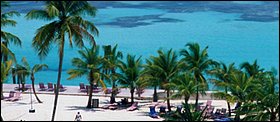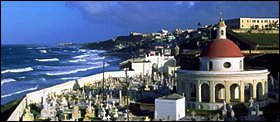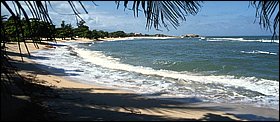|
Nassau,
Bahamas

ATTRACTIONS
With only a day
or so in port, you’ll want to spend your time seeing the best Nassau
has to offer. Here are my recommendations.
SIGHTSEEING
IN NASSAU
The
Bahamian capital has a long and intriguing history that’s reflected in
its colonial buildings and breezy public squares. Though its narrow
streets are often mobbed with visitors, you can see most of the city’s
historical sites on foot. A pleasant way to get oriented, however, is to
take a surrey ride around town. You can usually find several around Rawson
Square, which is the heart of downtown Nassau, or on Woodes Rogers
Walk. (Expect to pay about US$10 a person for a 30-minute ride.)
If
you decide to tour the local attractions on your own, you can easily see
the major sights in a few hours. At the very least, stroll through Parliament
Square, where a statue of Queen Victoria presides over an assortm ent
of Georgian-style government buildings that went up in the early 1800s. A
few blocks to the west, on Hill Street, is the regal yet undeniably pink Government
House. Among others, the Duke and Duchess of Windsor lived there when
he was governor during World War II. Check to see when the Changing of
the Guard ceremony is—it can be quite fun to watch. (It’s usually
on alternate Saturdays.) Just south of Parliament Square is the octagonal Public
Library, which was originally a prison (it was built in 1798).
For
the best view on the island, climb the 66-step Queen’s Staircase
to Fort Fincastle and go to the top of the adjacent water tower
(open Monday-Friday 9 am-4:30 pm and Saturday 9 am-3:30 pm).
You
could duck into the Pompey Museum on Bay Street, former site of the
slave market—it’s now dedicated to the history of slavery. Don’t
miss the paintings of unschooled artist Amos Ferguson on the second floor
(open Monday-Friday 10 am-4:30 pm, Saturday 10 am-1 pm; US$1 adults,
US$0.50 children). As long as you’re back on the waterfront strolling
along the mosaic promenade known as Woodes Rogers Walk, check out
the Junkanoo Expo with its displays of outlandish costumes used in
the festival (open daily 9 am-5:30 pm; US$2 adults, US$0.50 children).
Then you could stop at the Straw Market to buy straw hats, bags and
mats, wood carvings and T-shirts.
SIGHTSEEING
ON PARADISE ISLAND
Once
a scrubby feedlot called Hog Island, this spot of land off Nassau has been
transformed into the high-rise gambling and leisure haven of Paradise
Island, which is connected to Nassau by a bridge. The center of it all
is the Atlantis Resort, which South African developer Sol Kerzner
has turned into one of the most complete resort-casino complexes in the
world. The huge property includes a 14-acre/6-hectare waterscape with
cascades, a lazy river for tubing and—the highlight—a giant outdoor
saltwater habitat filled with sharks (you walk through a glass tunnel i n
their midst). In addition, there’s a lagoon for snorkeling—all just
off a gorgeous white-sand beach. Both the Atlantis Casino and the
waterscape are public areas, open to nonguests. The tunnel through the
aquarium is free; you pay fees to rent tubes or mats for the attractions
that require them. There is so much to do that you could easily spend the
day there going from one activity to another. The complex includes two
resort hotels as well as numerous restaurants.
If
you need to get out of the sun and are interested in formal gardens, the
nearby Ocean Club resort (also owned by Kerzner) contains the Versailles
Gardens and French Cloister. The original developer of Paradise
Island, an heiress of the A & P Company fortune, not only re-created a
formal European terrace garden, but also imported a 14th-century
Augustinian cloister stone by stone—and threw in an eccentric assortment
of statuary besides. Admission is free. Cab fare from Rawson Square runs
about US$5 a person each way. Or take the ferry from the dock on Woodes
Rogers Walk for US$2 each way. Or walk across the toll bridge for US$0.25.
Charlotte
Amalie, St. Thomas

ATTRACTIONS
St.Thomas
is the premier duty-free shopping island in the Caribbean. There are
hundreds of incredible shops here so leave plenty of time for shopping.
You might want to do your sightseeing early in the morning and spend the
rest of the afternoon shopping. With a jewelry store every 10 feet, if you
can't find the piece of jewelry you want, it probably doesn't exist on the
planet !! HAVE FUN !!! SIGHTSEEING
Beyond
the crowds on Main and Back Streets is a Charlotte Amalie rich in history.
If you venture along the less-traveled streets and brick alleyways,
you’ll stumble upon lovely old churches and Danish homes. Pastel-pretty
Charlotte Amalie was built by the Danes in the 1600s as a haven for
seafarers and—despite the intrusion of people and commerce—the town
has maintained some of its 17th-century charm. The best way to see the
sights is on a walking tour—pick up a free map from the visitors
information center at Havensight or in Charlotte Amalie.
Fort
Christian, painted red with a clock tower on top, is one of the oldest
structures in the Virgin Islands, dating from 1672. Only part of it is
open, but there is a s mall museum in what used to be a dungeon. Open
weekdays 8:30 am-4:30 pm, but the fort is being restored, so call ahead in
port: 340-776-4566. Near the fort is the pastel green Legislative Building,
where visitors can observe the Senate when it’s in session.
Seven
Arches Museum on Government Hill is an impeccably restored
18th-century Danish residence filled with mahogany furniture from Barbados
and other Caribbean islands. Leave yourself plenty of time for this
museum, as owner and restorer Philbert Fluck is as fascinating as the
museum itself. (The fruit punch he serves isn’t half bad, either.) admission fee US$5. Up the hill from the museum is
Blackbeard’s Castle, once the site of a pirate lookout, later a
fort and, until recently, a hotel. There’s still a stonework look-out
tower that’s in good repair, though off limits to visitors. Even so, the
view from the hill makes the climb well worth it: Take the Street of 99
Steps, a relic from the early 1700s. (Try counting the steps on your
way up or down: I tallied 103...lol .)
The
town has some distinctive old churches and synagogues, all worth visiting.
Beracha Veshalom Vegmiluth Hasidim, for instance, was built in
1833, making it one of the oldest synagogues in the Western Hemisphere.
(Note its sand-covered floors.) The Dutch Reformed Church, built in
1846, is a striking example of Greek Revival architecture. You can also
stop in the Gothic-looking Frederick Lutheran Church, which was
built in 1826, and the Memorial Moravian Church, built in 1884 of
blue-colored volcanic rock.
On
the outskirts of Charlotte Amalie is Frenchtown, a fishing village
established by the French Huguenots. A cluster of restaurants make the
town a pleasant place to spend an afternoon or evening (it’s not just
popular with tourists—you’ll see plenty of locals, too).
San
Juan, Puerto Rico

SIGHTSEEING
Old
San Juan is stunning. Narrow streets lined with colorful Spanish colonial
buildings are punctuated with shady plazas. Giant wooden doors grace the
facades of the oldest buildings (some date back 500 years), most of which
have undergone facelifts recently. Bougainvillea spills off balconies.
Around every corner, you’ll find a new treat: an old Spanish wall, a
tiny chapel, intricate street statuary or a marker noting an historic
event that took place at that spot. There will be organized tours from the
ship but you could easily walk the cobblestone
streets for hours and not be bored. But you’ll likely miss something
you’d regret later. So arm yourself with a map and select a few places
that interest you most; then walk or catch a trolley to as many sights as
you can visit without rushing. You can also join an organized walking
tour arranged on the ship. Allow time to rest in one of the shady parks or
plazas and enjoy a pineapple piragua (snow cone).
From
the port, head west to La Casita, a little pink Spanish colonial
building that houses a government tourism office where you can pick up
brochures, maps and a complimentary welcome cocktail made with Puerto
Rican rum. (Outside La Casita, look seaward in the opposite direction of
the cruise berths and you’ll see the Customs Building, a much larger
pink structure with Moorish touches.) From the tourist office, walk west
along Paseo de la Princesa, a 19th-century esplanade lined with
benches and mini-plazas with outdoor sculptures and large open areas where
concerts are performed during island holidays and festivals. Before you
reach the giant outdoor fountain, you’ll pass the gray colonial building
known as La Princesa, once a prison and now the headquarters of the
government-run Puerto Rico Tourism Company. Although La Princesa does not
have a permanent art gallery, it frequently hosts special exhibits of
Puerto Rican art and handicrafts. (The building is open weekdays 8 am-4
pm.)
The
lovely promenade winds alongside the old Spanish wall to its end at the San
Juan Gate, one of the original seaside entrances to the city.
Completed in 1639, this gateway known in Spanish as “La Muralla” used
to open each morning to let in merchants and people on government business
and then close at sunset to keep out pirates. Once through the gate, you
enter a delightful neighborhood of cobblestone streets. To your right is
the side entrance to La Fortaleza, the governor’s mansion. This
magnificent colonial building is the oldest governor’s home still in use
in the Western Hemisphere and listed as a UNESCO World Heritage Site. Free
guided tours through sections of the mansion and its grounds are offered
Monday-Friday. The
main entrance is at the end of Calle Fortaleza.
To
the left (and uphill) as you pass through the gateway is La Rogativa
Plaza, which contains a sculpture commemorating a day in 1797 when the
women of San Juan averted a siege by British ships. The women, led by the
bishop, carried torches in a religious procession in honor of St. Ursula.
The invaders, believing the torches were carried by Spanish military
reinforcements, fled. (The plaza offers splendid views of the harbor.) Just
above the plaza is the steep walkway into the grounds of Casa Blanca,
built in 1521 as the home of Spanish explorer Juan Ponce de Leon (the
first Spanish governor of Puerto Rico). Ponce de Leon died before the
building was finished, but generations of his family called the estate
home. Today it is a museum depicting life as it was in the 1500s-1800s.
(Open Tuesday-Sunday 9 am-4:30 pm; admission to the grounds is free; US$1
admission to the museum.
You
can follow the paved path running northwest through the estate and emerge
in view of Fuerte San Felipe del Morro, better known as El Morro
Fortress. Even if you’re not interested in military history, the
view alone from this UNESCO World Heritage Site makes it worth a visit.
(Be aware that it’s a long walk from the street to the fort on ragged
cobblestones.) This sprawling military complex, which has guarded the
entrance to San Juan Bay since the 1500s, is the most photographed site in
Puerto Rico. Walk along its 20-ft-/6-m-thick ramparts or enter one of its
distinctive sentry boxes, which have become the symbols of San Juan.
Within the fort are six levels of tunnels, dungeons and passageways that
invite exploration. Be sure to climb to the lighthouse level for a
bird’s-eye view of the city. If you haven’t had your fill of forts,
proceed east on the palm-lined streets overlooking the ocean to the larger
Fort San Cristobal, which was built to protect the city from a land
invasion. The views of El Morro and the old city are quite spectacular
from San Cristobal. (Both forts are open daily 9 am-5 pm; a single US$2
National Park Service ticket gets you into both.
As
you walk from El Morro to San Cristobal, you’ll pass the north side of
the Plaza del Quinto Centenario (Quincentennial Square). This giant
plaza frequently hosts outdoor music and dancing extravaganzas and is a
favorite spot for skateboarders, government workers taking a lunch break
on a bench and mothers out for a stroll with their toddlers. It opened in
1992 as part of the celebration of the 500th anniversary of Columbus’
arrival in the New World. Its centerpiece, a 40-ft/12-m totem pole-style
sculpture, has drawn criticism as being too modern for the old city. At
the south end of the plaza, two needle-shaped columns point to the North
Star, the guiding light of the early explorers. Nearby is the Cuartel
de Ballaja, a colossal barracks built as home for the Spanish troops
and their families. Today a handful of its rooms serves as galleries for
the Museum of the Americas, with its marvelous permanent exhibit of
Latin American folk art and its changing exhibits dedicated to the work of
Spanish and Latin American painters and sculptors. Open Wednesday-Sunday
9 am-4:30 pm; no admission fee.
In
the block to the east of the art museum sits Plaza de San Jose,
marked by a statue of Ponce de Leon made from melted-down cannons that
were captured from the British in the late 1700s. This popular colonial
plaza is surrounded by historic buildings, including the San Jose
Church, the second-oldest church in the Western Hemisphere (open
Monday-Saturday). Also nearby is the Museo de Pablo Casals (Pablo
Casals Museum). The Spanish cellist’s mother was Puerto Rican, and he
spent the last decades of his life on the island. The museum contains his
manuscripts, photographs and videotapes (open Tuesday-Saturday 9:30
am-5:30 pm, free admission). Also on the plaza is the Institute
of Puerto Rican Culture bookstore, but don’t think books are the
only thing it sells. This restored building displays everything from
coffee and hammocks to mango jam and top-quality crafts. Calle Norzagaray
at Plaza San Jose
Head
downhill on Calle Cristo from Plaza San Jose and you’ll pass the Catedral
de San Juan. The original cathedral went up in the early 1500s, but
the current structure dates to 1852. Inside on the left side of the church
is the dramatic white-marble tomb of Ponce de Leon. (The cathedral is a
popular spot for society weddings.) Across the street is El Convento,
a 17th-century cloistered convent that has been converted into a hotel. If
you have time, take a look inside at some if its artifacts: The bell that
once perched over the Carmelite nuns’ chapel is displayed in the foyer,
along with some lovely Spanish colonial art and furniture. A couple of
blocks away is the Plaza de Armas, the pulse point for Old San
Juan. Centuries ago, Spanish soldiers practiced their drills on this
square. Today, children chase pigeons across the plaza, retirees grab a
bench under a shade tree, young couples sip coffee at the plaza’s
outdoor cafe and people head in and out of City Hall, an 1813
structure that has recently been restored. (An information desk on the
ground floor has walking maps of the old city.)
On
the eastern edge of the old city is Plaza Colon, dominated by a
statue of Cristobal Colon—the man that English speakers know better as
Christopher Columbus. Bronze tablets on the pedestal tell of Columbus’
life.
The
plaza marks the edge of Old San Juan: Roads heading east lead to the
trendy shopping, restaurant and hotel districts concentrated along the
beaches in modern Condado and Isla Verde. Hato Rey is
the city’s financial district. In between are residential neighborhoods,
which run the range from luxury high-rise condos with ocean views to urban
slums.
The
Bacardi Rum Distillery, one of the most popular attractions outside
San Juan, is in Catano across San Juan Bay (could it be the free drinks?).
Said to be the world’s largest, the rum plant distills up to 100,000
gallons a day. Many tours feature the distillery, but you can also visit
on your own by taking the ferry from Pier 2 to Catano (they run every half
hour; US$0.50 per person) and then a cab or publico (US$6) right to
the plant. (Open Monday-Saturday 9:30 am-3:30 pm
Labadee,
Hispaniola

ABOUT
THE REGION
Only Royal Caribbean ships can visit this
place, where some of the best scenery and beaches in the Caribbean are
reserved exclusively for our guests. We offer floats, paddle boats,
sailboats, banana raft rides, swimming, and snorkeling in turquoise
waters. Play volleyball or explore ruins more than 200 years old. Or shop
for authentic Haitian art.
HIGHLIGHTS
Labadee Coastal Cruise
Learn the rich history of this mystical land, and see
how the Haitians still live as they did over two hundred years ago. Play
in the same waters once paddled by Arawak Indians in dugout canoes. Watch
native Voodoo dancers perform local songs and dances, and enjoy a
delicious complimentary rum or fruit punch.
|